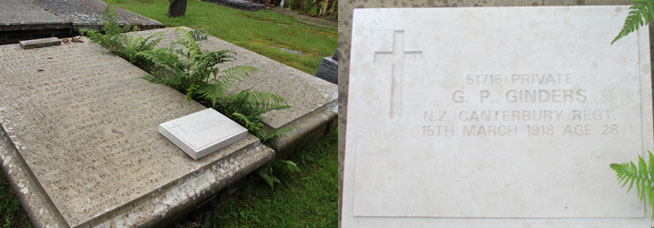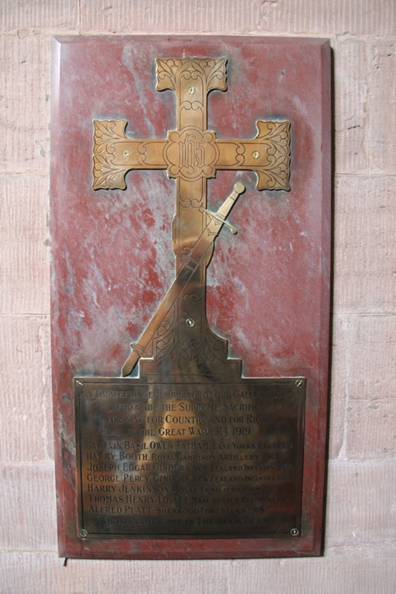


A folder, created in 2018 to mark the centenary of the Armistice of the Great War, giving details of those from within the community who gave their lives for their King & Country in the two World Wars, is kept in church, alongside the timeline of the history of the church.
Mounted on the north wall of the chancel are two War Memorial plaques. Image 1 commemorates WW1 (The Great War).

The inscription reads:
“In grateful remembrance of our gallant dead who made the supreme sacrifice for King, for country, and for the right in the Great War 1914 – 1919”
Captain Basil Owen Tatham East Yorks Regt 1915
Harry Booth Royal Garrison Artillery 1915
Joseph Edgar Ginders New Zealand Infantry 1915
George Percy Ginders New Zealand Infantry 1918
Harry Jenkinson Royal Fusiliers 1918
Thomas Henry Lovatt Manchester Regiment 1918
Alfred Platt Sherwood Foresters 1918
“Whose names are in the book of life”
The graveyard contains one War Grave, as recognised by the Commonwealth War Graves Commission, that of George Percy Ginders. The CWGC have mounted an inscribed stone plaque onto the family tomb, which is located midway along on the south side of the church.

George followed his elder brother Joseph Edgar into the New Zealand Expeditionary Force, and served on the Western Front. He was invalided out to the 1st New Zealand General Hospital UK in Brockenhurst, where he died of meningitis on 15th March 1918.
The following four individuals are memorialised in the graveyard:
Captain The Hon Arthur Edward Bruce O’Neill ‘A’ Squadron 2nd Life Guards
Second Lieutenant John William Bailey 3rd Cheshire Battalion
Private William James Willshaw 8th Battalion South Lancashire Regiment
Private Joseph Edgar Ginders New Zealand Expeditionary Force
Additionally, there is the grave of Archibald Angelbeck (King’s [Liverpool] Regiment), who was wounded in the Great War, and subsequently died in 1922. Finally, there are the graves of John Sidney Austin and Henry Leslie Eden, two victims of the Minnie Pit Disaster 12th Jan 1918. Those working in the mining industry served in ‘Other Empire Force’ with the rank of ‘Coal Mine Worker’. Henry had previously served in the 9th Battalion North Staffordshire Regiment, before being invalided out, and then he joined the mining industry, going underground at the Minnie Pit, Halmerend.
World War II Reginald Holland was, in fact, Joseph Reginald Holland [known locally as Joey] who served as a gunner in the Anti-tank regiment, Royal Artillery, killed in Burma Feb 1945 aged 23.

With kind thanks to Gill & Dennis Thorley for providing the content for this page